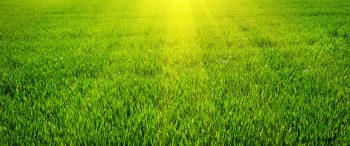 Everyone wants a lawn that looks good year round. Finding the right grass for your yard can be easy if you know the conditions in which it will grow.
Everyone wants a lawn that looks good year round. Finding the right grass for your yard can be easy if you know the conditions in which it will grow.
Things to consider when choosing a type of grass are sun/shade exposure, soil conditions, and how much maintenance you are willing to do. Another thing to look for is how the grass will do in winter. Some varieties will even keep color during the winter months with proper care.
There are several varieties that handle North Texas winter months well. They can go dormant, or with care, can stay green year-round.
Bermuda Grass
Bermuda is the most common type of grass grown. It is hardy and drought tolerant. Bermuda grows best in full sun, so it is not a good option for yards with lots of tree coverage.
Bermuda grass can go dormant when the temperatures outside start to drop. It will quickly come out of that dormancy when the temperatures start to rise again.
Bermuda grass has the ability to stay green during winter months if the average temperature is above 50 degrees. Along with the full sun, keep Bermuda grass should be well-drained, and mowed and fertilized regularly during the growing season.
St. Augustine Grass
The second most common grass grown in North Texas is St. Augustine. St. Augustine is not native to Texas but can perform well here.
It is not as hardy as Bermuda grass, and can also be more susceptible to disease and pests. St. Augustine needs more watering and may struggle over winter. It does grow in the shade, however.
Properly maintained, this grass type resembles carpet, making it an ideal grass for a beautiful lawn for those willing to put in a little extra work.
Zoysia Grass
Zoysia grass can also handle the shade better than Bermuda grass. Additionally, it has the ability to stay green during the winter. It is relatively disease and pest resistant, but is not very tolerant to drought.
Zoysia needs dethatching every spring. It doesn’t grow much in the winter and may only need to be mowed once or twice during December through February.
Zoysia is hardier in colder temperatures than Bermuda grass as well. It is less likely to incur damage from the cold.
This grass needs to be fertilized during its growing season to keep its color in winter and in the fall to prepare for its dormancy. It should be well watered at the start of winter but not during to lessen the likelihood of it developing disease.
Learn more about why these three are considered the Best Grasses for North Texas.
Buffalo Grass
Buffalo grass is a gray-green or blue green perennial turf grass. It needs full sun and has little tolerance for the shade.
This is a low-maintenance grass. It goes dormant in the winter and can be left alone for longer lengths than the other grasses.
Buffalo grass is a good option for those seeking a drought-tolerant turf. It only needs a sparse 1 ½ inches of irrigation per year. However, it does not do well in sandy soils.
Tall Fescue
Tall fescue is a grass well-suited for the area of North Texas. It is a cool season grass that works well in transition areas. It has a greater heat tolerance than most cool season grasses and a greater cold tolerance than warm season options. This makes it ideal for a year-round beautiful lawn.
This grass is both shade tolerant and disease resistant. It will grow most vigorously during the cool spring and fall months.
Tall fescue should be watered deeply but infrequently, and mowed to maintain a height of 2 to 3 inches. It adapts well to a variety of soil conditions and is moderately tolerant of drought, needing more watering in the summer season.
